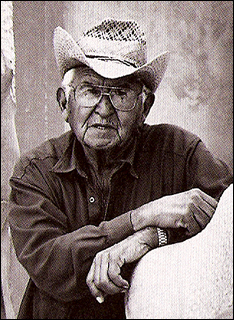Santa Fe Living Treasures – Elder Stories
<<Back to Treasures Index Allan HouserFATHER OF CONTEMPORARY | Allan Houser1984, when the award was created, the National Medal of Arts has gone to a dozen luminaries each year, Georgia O'Keeffe, Marian Anderson, Ella Fitzgerald and Aaron Copeland among them. In 1992 it went to Allan Houser, the sculptor whose works—monumental, intimate and steeped in history—are at home everywhere from the Smithsonian in Washington to the Pompidou Museum in Paris. He was the first Native American to win the award. Some might say it was long overdue. A Chiricahua Apache, Allan was born on his parents' government-grant farm in Apache, Oklahoma in 1914, as the tribe was emerging from twenty-seven years as US prisoners of war, in forced exile from their native mountains in the Southwest. Allan's father, Sam Haozous, was captured with Geronimo in 1886, and later served as the great chief's interpreter. Allan grew up listening to his father play the drum, sing medicine songs and tell the stories of Geronimo. In 1934, Allan came to Santa Fe to study art at the Santa Fe Indian School, changing his name from Haozous (which means "the sound of pulling roots") to Houser. "Dorothy Dunn was the first teacher I had." Allan studied painting, but he "wanted more," and said, "I had something else in mind when I came here. I didn't want to do Indian-style paintings. I didn't care for it at all, but that was the only way that I could get into the arts." Dunn objected to some of the things Allan wanted to do, and told her student, "We don't do that here." In 1962, when Allan became a teacher at the Institute of American Indian Arts, his students heard a different message. "We do everything." Allan met his wife of more than fifty years, the former Anna Marie Gallegos of Abiquiu, in Santa Fe. Allan and Anna Marie raised five sons. Allan received his first commission for a sculpture in 1949 from the Haskell Institute in Lawrence, Kansas—a memorial in stone of Indian servicemen killed in World War II. He later received a Guggenheim grant in sculpture and painting. "When I won my Guggenheim fellowship, I said I wanted to become one of the best—whether painter or sculptor—in the world. That's what my efforts are going to be, whether I get there or not," he said. "Allan taught a whole generation of new Indian artists," said Robert Breunig, former chief curator of the Heard Museum in Phoenix. "I think we can safely say he is the father of contemporary Indian sculpture." Please see Volume 1 for complete text. |
